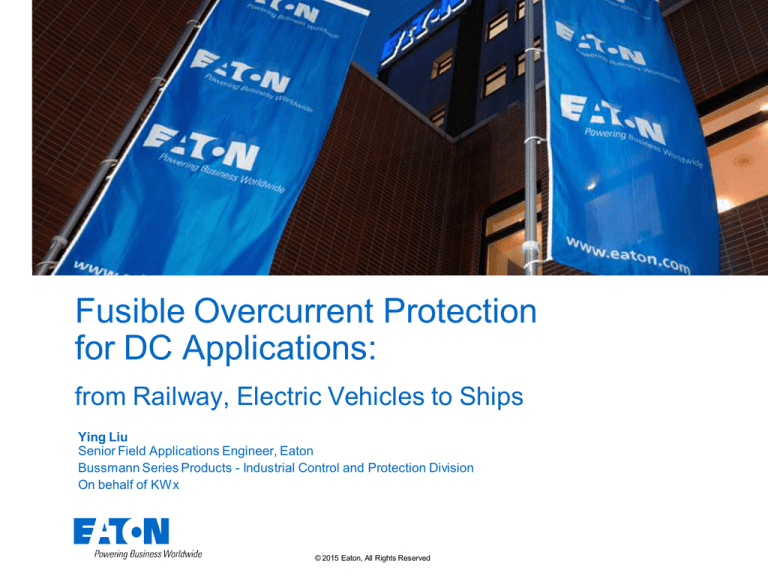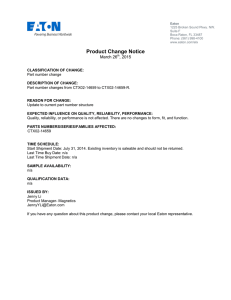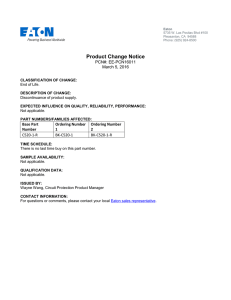
Fusible Overcurrent Protection
for DC Applications:
from Railway, Electric Vehicles to Ships
Ying Liu
Senior Field Applications Engineer, Eaton
Bussmann Series Products - Industrial Control and Protection Division
On behalf of KWx
© 2015 Eaton, All Rights Reserved.
Agenda
•
•
•
•
•
Introduction
The fuse basics
Why is DC special?
Fuse selection in DC applications
DC application examples
• Railway/Traction
• Electric Vehicles
• Common DC bus systems/Marine
• Summary
© 2015 Eaton, All Rights Reserved.
2
Introduction
© 2015 Eaton, All Rights Reserved.
3
Why Choose Eaton?
• Eaton is a leading diversified power management company
• Eaton offers the most comprehensive Bussmann series fusible
circuit protection solutions - Over 100 years experience
• Global manufacturing and distribution for world class lead time
• Global accreditations – IEC, DIN, BS, UL, CSA, CCC….
• Worldwide Field Application Engineers (FAEs) to assist in fuse
selection and application advice
© 2015 Eaton, All Rights Reserved.
4
What can Eaton FAE do for you
• General enquiries:
•
Cross References / Alternatives
•
Accessories
•
Datasheets
• Fuse Selection/Technical Solutions
• Develop Customised Products
•
new ratings, dimensions, connections, testing, approvals/standards, mini NPD
• Training/seminars/workshop
• Supporting early Design-in
We promote Engineer to Engineer discussion.
Our goal is to offer First Class Technical Applications support.
© 2015 Eaton, All Rights Reserved.
5
The Fuse Basics
© 2015 Eaton, All Rights Reserved.
6
What is a fuse link?
• A device to protect an electrical circuit due to excessive
current flow.
• Essentially a thermal device, excessive current causes the
fuse link to heat up, melt and isolate the flow of current in a
controlled manner.
Fuse
Fault
Current I
Power
V
source
Cable
© 2015 Eaton, All Rights Reserved.
7
7
What are High Speed Fuses (HSF) for?
• For the protection of semi-conductors
or applications with semi-conductors
• Diodes
• Thyristors
• GTOs
• IGBTs
• Etc.
© 2015 Eaton, All Rights Reserved.
8
HSF Applications
• Drives
• UPS
• Soft starters
• Traction
• Crane & mill
controls
• Power
rectifiers
• PV
© 2015 Eaton, All Rights Reserved.
9
Why is DC special?
© 2015 Eaton, All Rights Reserved.
10
AC Applications
• Q: I want a fuse rated at 500A 1000Vac.
• A: We have these fuse options: xxx, xxx, …
© 2015 Eaton, All Rights Reserved.
11
DC Applications
• Q: I want a fuse rated at 500A 1000Vdc.
• A:
What is your application?
Is it a classic DC or contains capacitance?
What is the max and min time constant in your
system?
What is the min and max fault level?
…
Why do we ask so many questions for DC applications?
© 2015 Eaton, All Rights Reserved.
12
AC faults
• Current:
Frequency/shape of
fault/rise rate defined
• Voltage:
Zero crossing
Current
Voltage
© 2015 Eaton, All Rights Reserved.
13
DC faults - current
• Classic DC (E, L, & R)
Defined by L/R
• Non-Classic DC (with C)
Can be anything
200,00
100,00
0,00
-100,00
-200,00
Discharge Non Oscillating
14
12
Current in KA
10
© 2015 Eaton, All Rights Reserved.
8
6
4
2
0
time
14
DC faults - voltage
• No natural zero crossing
– arcing difficult to switch off
Current
Current
Voltage
Voltage
BANG !
© 2015 Eaton, All Rights Reserved.
15
DC capability
• DC performance of a fuse depends on
• Type of fault loop (classic DC or not)
• System DC voltage Eg
• Time constant TC (L/R) of the fault loop
• Fault level Ip
© 2015 Eaton, All Rights Reserved.
16
DC voltage capability v.s L/R
DC voltage capability v.s. L/R
Condition: min Ip is achieved
© 2015 Eaton, All Rights Reserved.
17
Min Ip
Ip F x I 2t
[A]
E.g.:
F = 26.5 for L/R=40ms
Min Ip needs to be observed
© 2015 Eaton, All Rights Reserved.
18
DC performance
• All fuses are AC fuses
• All fuses can be used for DC
• AC data – not applicable for DC applications
• DC data – only valid for specific conditions
(TC, Ip, Eg, etc)
© 2015 Eaton, All Rights Reserved.
19
Values of DC performance
• All fuses are AC fuses
• All fuses can be used for DC
• AC data – not applicable for DC applications
• DC data – only valid for specific conditions
(TC, Ip, Eg, etc)
© 2015 Eaton, All Rights Reserved.
20
Values of DC performance
• All fuses can be used for DC
• Single fusing solution
• Time constant
• Min Ip
• Series fusing solution
• Time constant
• Min Ip => fuses to melt within 10ms
• Two 690Vac fuses in series – up to 900Vdc
• Two 1000Vac/1250Vac in series – up to 1400Vdc
© 2015 Eaton, All Rights Reserved.
21
Values of DC performance
• All fuses are AC fuses
• All fuses can be used for DC
• AC data – not applicable for DC applications
• DC data – only valid for specific conditions
(TC, Ip, Eg, etc)
© 2015 Eaton, All Rights Reserved.
22
Values of DC performance
• AC data – not applicable for DC applications
© 2015 Eaton, All Rights Reserved.
23
Values of DC performance
• All fuses are AC fuses
• All fuses can be used for DC
• AC data – not applicable for DC applications
• DC data – only valid for specific conditions
(TC, Ip, Eg, etc)
© 2015 Eaton, All Rights Reserved.
24
Values of DC performance
• DC data – only valid for specific conditions
(TC, Ip, Eg, etc)
© 2015 Eaton, All Rights Reserved.
25
DC application examples
© 2015 Eaton, All Rights Reserved.
26
DC application 1 – Railway/Traction
© 2015 Eaton, All Rights Reserved.
27
Railway/Traction
• Voltage Dimension
• Traction systems often have large tolerances on system
voltages
Variation of voltage with distance along track
1000
voltage
800
780Vdc Max
683Vdc Avg
585Vdc Min
600
400
200
10
System voltage:
20
30
distance
650 Vdc Nominal
© 2015 Eaton, All Rights Reserved.
40
50
with +20% / -10%
28
Railway/Traction
• Voltage Dimension
• Traction systems often have large tolerances on system
voltages
• Possible Regenerative breaking
• Circuit time constant and fault levels may vary along the track
Important to know the upper and lower limit
to address all possible fault conditions
© 2015 Eaton, All Rights Reserved.
29
Railway/Traction
• Current Dimension
• Continuous Operation
Cyclic loading – accelerating, braking, coasting, auxiliaries running
Possible high ambient temp within an enclosure
Possible lost shoe operation
• Fault Situations
Close to substations – high available fault current, low time constant
Long distance from substations – low available fault current, high time
constant
Boundaries of fault conditions need to be quantified
• Coordination with circuit breakers makes selection process
even more difficult
© 2015 Eaton, All Rights Reserved.
30
Railway/Traction
• Fuse link and breaker
• Breaker deals with low fault current with long time constant
• Fuse link deals with high fault current and short time constant
• HSF protects HSCB when fault currents are higher and faster
than the breaker can reliably protect
• Overlap – both fuse link an breaker will operate but breaker still
protected
• Fuse link operates and needs replacing
• HSCB can be safely reset
© 2015 Eaton, All Rights Reserved.
31
Railway/Traction
• Fuse link and breaker
The range fuses must clear the faults needs to be clearly defined.
© 2015 Eaton, All Rights Reserved.
32
Railway/Traction
• Fuse link and breaker
Circuit breaker
Fuse link
© 2015 Eaton, All Rights Reserved.
33
DC application 2 –
(Hybrid) Electric Vehicles
© 2015 Eaton, All Rights Reserved.
34
Electric Vehicles
• Voltage Dimension
• HEV typically has low time constant, making it more
comparable with the current AC characteristics of the fuse
• Current Dimension
• Cyclic loading profile – Difficult to define
• Very high and very low ambient temperatures
• Typical: -40oC +105oC
• Small cables/In a box
© 2015 Eaton, All Rights Reserved.
35
Electric Vehicles
• Other considerations
• Trend to go higher power => size
• Space constraint
• Compromise between lifetime and fast acting
• High shock and vibration
• End tag options
• EV Applications push standard industrial fuses to
design limit.
• No global standards
Each application is unique, complicated, requiring customized design.
© 2015 Eaton, All Rights Reserved.
36
DC application 3 – Common DC bus
systems/Marine
© 2015 Eaton, All Rights Reserved.
37
Common DC bus systems/Marine
• Typical circuit diagram
• Common DC bus system
• One or multiple AFEs, rectifiers, inverters
• High short circuit current levels
• Selectivity can become a challenge
© 2015 Eaton, All Rights Reserved.
38
Common DC bus systems/Marine
• Conventional configuration
• Common DC bus system
© 2015 Eaton, All Rights Reserved.
39
Common DC bus systems/Marine
We need current data file for all branches in all fault conditions.
© 2015 Eaton, All Rights Reserved.
40
Common DC bus systems/Marine
• Work out min required fuse ratings for F1-F4.
• Find possible fuse options.
• Start fixing with the most tight fuse.
• Check selectivity.
• When selectivity can’t be achieved,
go one (or more) rating up.
• Check selectivity again.
© 2015 Eaton, All Rights Reserved.
41
Common DC bus systems/Marine
• In event of SC fault in F4 branch:
•
•
•
•
•
•
F4 will melt after 0.16ms
F4 will clear after 0.23ms (arc voltage to be estimated)
Accumulated I2t(F1)=40A2s only@0.23ms,
so Fuse F1 will not melt. => OK
Accumulated I2t(F2)=17.3kA2s @0.23ms
< F2 Fuse melting I2t = 28kA2s,
so Fuse F2 will not melt. =>OK
Accumulated I2t(F3)=18.3kA2s @0.23ms
<F3 Fuse melting I2t = 28kA2s,
so Fuse F3 will not melt. => OK
So selectivity in event of F4 branch SC s achieved.
• Repeat the above for all fault scenarios
@worst case (min & max).
© 2015 Eaton, All Rights Reserved.
42
Summary
© 2015 Eaton, All Rights Reserved.
43
Summary
• DC is more complex than AC applications
• No generally applicable technical data for DC
• DC performance associated with:
• Type of fault loop
• Eg
• L/R & Ip (or data file)
• Let us help you select the right DC fuse
© 2015 Eaton, All Rights Reserved.
44
© 2015 Eaton, All Rights Reserved.
45


